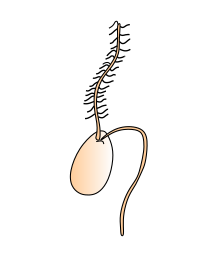Azoospore is a motile asexual spore that uses a flagellum for locomotion in aqueous or moist environments.[1] Also called a swarm spore, these spores are created by some protists, bacteria, and fungi to propagate themselves. Certain zoospores are infectious and transmittable,[1] such as Batrachochytrium dendrobatidis, a fungal zoospore that causes high rates of mortality in amphibians.

Zoospores are composed of a microtubular cytoskeleton base which extends from the base of the flagellum. The complexity and structure of this cytoskeleton is variable and is largely dependent on volume and size.[2] One common feature of zoospores is their asymmetrical shape; a result of the ventral grove housing the flagella base. Certain zoospores progress through different phases, the first phase commonly referred to as 'the initial'.[2] Others form cysts that vary tremendously in volume (14-4905 cubic micrometers) and shape, each with distinctive hair structures.[2]
Zoospores may possess one or more distinct types of flagella - tinsel or "decorated", and whiplash, in various combinations.
Both tinsel and whiplash flagella beat in a sinusoidal wave pattern, but when both are present, the tinsel beats in the opposite direction of the whiplash, to give two axes of control of motility.
Attachment to the base of the zoospore is variable between taxa and may help with identification of species.[2]
Ineukaryotes, the four main types of zoospore are[3] illustrated in Fig. 1 at right:
A zoosporangium is the asexual structure (sporangium) in which the zoospores develop in plants, fungi, or protists (such as the Oomycota). Developing sporangia of oomycetes go through a process of cleavage in which a protein kinase, in the case of Phytophthora infestans, induces the sporangial cytoplasm to split and release the various zoospores.[4] Release of the spores can occur either inside of the zoosporangium (intrasporangial zoosporogenesis) or exteriorly (extrasporangial zoosporogenesis).[2] Spores absorb water and travel through the cell membrane for excretion.[2]
Different fungal zoospores may infect different taxa of organisms. Due to zoospores' aquatic lifestyle,[1] fish and amphibians are ideal hosts. Some colonize exposed injuries in fish which may cause epidermal damage, leading to death in certain cases.[5] Others may utilize species of frogs (such as Bufo marinus and Rana catesbieana) as carriers, allowing extended ranges of travel.[1]